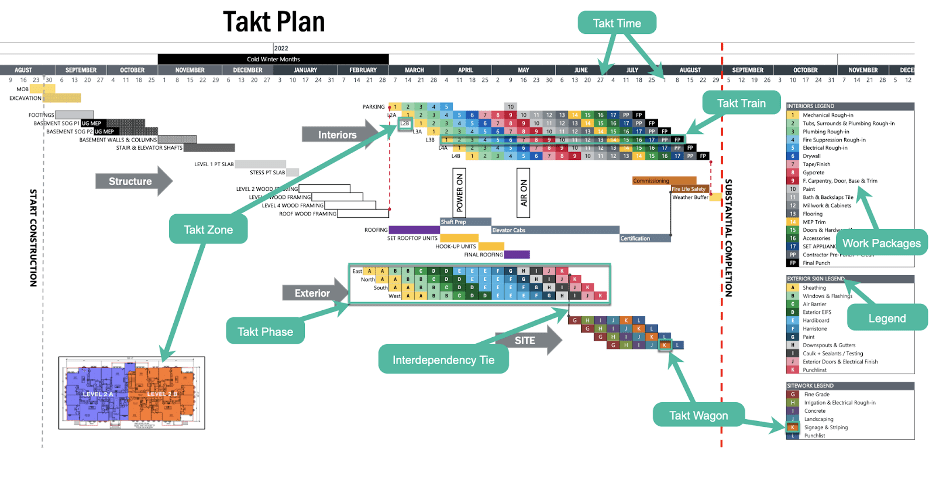17 PreCon Outputs
We’ve covered “When Should PreCon Begin?” and “Who and What Should PreCon Include?”
Now from our 75+ world-wide experts, from AGC and LCI professionals and our own 45 years of experience, here’s a list of “17 PreCon Outputs” – what the team can expect to have as a result of a great, early, collaborative PreCon process. We’re including some of the advice from our experts to amplify and clarify items on the list.

The magic sauce is what I call “the upfront investment of intelligence “. Bringing the brightest and most experienced to the team in PreConstruction provides for a more complete, constructible and affordable design. -Mark Drury, Founder, Mark Drury & Associates
Integrating Operations into the planning, budgeting, bidding and procurement of the
trades. When there is an easy transition from PreCon to construction because all the collaboration, communication and strategy it directly impacts what is being implemented on our projects and the culture that is being established from the very beginning! – Jen Lacy, Lean Practice Leader, Robbins & Morton
- Buildable Plans
Make sure Sustainability and Resilience Architecture are at the table for full building lifecycle performance. -Kasey Rios Asberry, Architect, Sustainability and Resilience Architecture
Do the basis of design (BOD), budget, and offsite/Prefab plan BEFORE the schematic design. This ensures a design that meets the budget and the construction intent. -Hal Macomber, Author, Lean Pioneer
For design/build in PreCon, there have been a few pain points over the years. The one that tends to recur is where the criteria docs are based on an assumed program. This usually results in changes that could’ve been mitigated by integrating the right staff upfront, from the owner’s side. -Tim Coyle, Senior PreConstruction and Construction Manager, Coyle Associates - Master Schedule
Schedule comes before anything else. The plan or “how you build” makes it so you can be safe, how you build is the reason it costs a certain way, and if you plan to have the correct amount of time and have a system to create flow you will set your team up to have less WIP and thus be able to manage quality. The sooner you can plan and get the whole team headed in the same direction the better off the downstream folks will be. If there isn’t a Superintendent in early design helping to find what should be prefabricated and how the building should be built then I don’t see consistency in results.-Spencer Easton, Takt Expert and Constructionist (formerly Superintendent and Scheduling Director)
This includes what those in the Construction Industry Institute’s Advanced Work Packaging (AWP) community call “Path of Construction”. - General Takt Plan


- Phasing Drawings
From a designer’s perspective we need “real” clear understanding/validation of the “constructability” of our approach. Phasing and/or construction sequencing limitations. I don’t want to design in a vacuum but design in such a way to facilitate the contractor. This initial discussion can occur before pen to paper. This will also facilitate cost concerns. -Tre Arnold, AIA, Regional Director of Healthcare, EwingCole - Coordinated Logistics
I believe in pre-planning, having strong communication and good relationship with trade partners to get the best deals. Have meetings on new products that might be cheaper and better and more efficient for the building. Be able to provide Alternative purchasing options. -Danielle Cortez, Project Estimator, Martines Palmeiro Construction
I work with all of my subs and suppliers to understand Lead times. More than ever with supply chain shortages, this is a critical element of making sure your projects stay in time. -Jared Thatcher, Lean Consultant, Port of Seattle
Start attacking longest lead items. Get material types approved ASAP. Define major subs. Iron out scopes, overlap some scopes if the budget allows, then plug in the trade partner who is not struggling. Identify mech bays (plumbing) HVAC DSA shaft, etc. Get the ID team hot! -Mark Inkenbrandt, Superintendent, Fairfield Residential - Right-sized team with good Relationships
Speaking from experience, my greatest concern during PreCon is “do we have the right people in the room?”. While everyone’s insight is relevant, is it relevant AT THAT STAGE? And conversely, I have had many, MANY people along the project say “Gee, I wish I’d known that earlier”. -Luca Cota Rasmusino, Lean Coach, Florence, Italy
We keep the entire team involved from the beginning. Estimators, project management team, project director, operations manager… all of us. It keeps everyone informed every step of the way. -Michael Boreham, Estimator, Aviation Group, Q&D Construction
Building your team of co-workers who all have the same mindset and drive and understanding of what the PreCon goals are. Finding the right resources in today’s environment is very difficult. Build the best team you can by starting early in setting up the team and do not compromise because of old friendships. -Peter Irion, Consultant
How are they going to work together so they can be efficient? I think the key idea to building that team is trust. -Kirk Hotstatter, PhD Candidate, University of Washington - Right-sized duration
The team could easily be setting itself up for crash landing late in the project, unless it assures it has triple-checked the project duration and right-sized the plan and schedule, following an ongoing collaborative analysis of:
- All of the systems, components and resources required to meet the owner-requested (demanded) completion date
- Risks, Constraints and unknowns
- And a good analysis of logistics and supply issues.
The PreCon team must determine that it actually CAN do this project in the duration to which it is committing.
- Supportive budgets for operational success
Have both PMCM and GC do comparable cost model estimates to establish early GMP Budget. -David Wood, PM at Marc Taylor, Inc.
A “key idea” is sitting alongside a good “conceptual” estimator during the design process. Providing “actionable” breakdown of the budgets – yes, target value design. Working together, define what does X-dollars of interior store front office partition get us? -Tre Arnold, AIA, Regional Director of Healthcare, EwingCole - Integration plan for IT
Different organizations use different platforms and software. This is inherently wasteful and often silos data and delays communication. The IT Integration Plan assesses these risks and gaps and iterates an agreed-upon resolution. Do it now or stumble during the whole project. - Risk and Opportunity Register (shared by all)
A clear understanding of assumptions and risks, and thus developing mitigation plans, and clear understanding of deferred decisions and accommodating them in the schedule. -Seulkee Lee, Global Lead, Schedule & Progress Manager, Genentec/Roche - Right trailers, facilities, and onsite support systems
Collaboratively plan the ONSITE OFFICE complex – absolutely with a Big Room, and hopefully co-located and not siloed. Thoughtfully, respectfully plan and provide FIELD FACILITIES detailed right down to upscale, clean worker bathrooms (as good as the highest-ranking execs) and lunch and break facilities. Respect for People really shines here. - The beginnings of a winning team culture
The culture you have built during PreCon sets the tone for the rest of the project all the way through Commissioning and Start-Up. This output should include the team’s collaborative, short statement of Values and Behaviors we will live daily during the project. And it becomes part of the ongoing Onboarding process for everyone who participates in the project. - Safety Plan!
Making Safety and Risk management important from the start is another way of setting your project up for success as well. I can go on for hours on the importance of a thorough PreCon is to a successful product and project. -Chris Marshall, Project Manager for many companies over the years
Safety includes Psychological Safety and emotional safety. Our industry leads all others in suicide and mental health issues. What’s the plan? - Quality Plan
1) Effectiveness of Communication in the key– As I grow deeper into my LEAN journey I believe this to be the secret sauce. Project teams jump knee deep into the technical PreCon activities without 1st establishing the framework, tools, procedures, and structure to effectively communicate. This is the root cause to many issues down the line. 2) Rules of Engagement and Problem Solving – identify, understand and agree 3) Establishing Project Milestones for Schedule, Completeness of Deliverables and clearly defining what is expected of these. -Terry Brickman, Quality Program Manager, PCL Construction - Target Cost and Cost Tracking Method shared with everyone


- Communication Plan
At all levels, across all horizontal teams – execs, managers, field:
- What are the agreed-upon protocols for email?
- How will we communicate (“push”) information broadly without using meetings?
- How can we minimize the number, length and size of meeting? Meetings should be reserved for collaboration.
- Do those who work together know how they each prefer to be contacted when it’s urgent?
- Security Plan (people & property)
Early public outreach – buy in from the community. -Christine Gorman, VP, Jacobs
There you have it! 17 PreCon Outputs for a winning project. And we’re open to hearing your ideas for #18, if there should be one.

